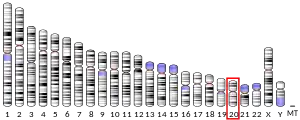RNF24
Ring finger protein 24 is a protein that in humans is encoded by the RNF24 gene.[5][6]
| RNF24 | |||||||||||||||||||||||||||||||||||||||||||||||||||
|---|---|---|---|---|---|---|---|---|---|---|---|---|---|---|---|---|---|---|---|---|---|---|---|---|---|---|---|---|---|---|---|---|---|---|---|---|---|---|---|---|---|---|---|---|---|---|---|---|---|---|---|
| |||||||||||||||||||||||||||||||||||||||||||||||||||
| Identifiers | |||||||||||||||||||||||||||||||||||||||||||||||||||
| Aliases | RNF24, G1L, ring finger protein 24 | ||||||||||||||||||||||||||||||||||||||||||||||||||
| External IDs | OMIM: 612489 MGI: 1261771 HomoloGene: 5223 GeneCards: RNF24 | ||||||||||||||||||||||||||||||||||||||||||||||||||
| |||||||||||||||||||||||||||||||||||||||||||||||||||
| |||||||||||||||||||||||||||||||||||||||||||||||||||
| |||||||||||||||||||||||||||||||||||||||||||||||||||
| |||||||||||||||||||||||||||||||||||||||||||||||||||
| |||||||||||||||||||||||||||||||||||||||||||||||||||
| Wikidata | |||||||||||||||||||||||||||||||||||||||||||||||||||
| |||||||||||||||||||||||||||||||||||||||||||||||||||
RNF24 binds TRPC6 (603652) and other transient receptor potential cation channel (TRPC) family members and is involved in regulation of intracellular trafficking of TRPCs.[6] In addition, RNF24 contains similarity to the Drosophila goliath protein and thus may function as a transcription factor.[5]
References
- GRCh38: Ensembl release 89: ENSG00000101236 - Ensembl, May 2017
- GRCm38: Ensembl release 89: ENSMUSG00000048911 - Ensembl, May 2017
- "Human PubMed Reference:". National Center for Biotechnology Information, U.S. National Library of Medicine.
- "Mouse PubMed Reference:". National Center for Biotechnology Information, U.S. National Library of Medicine.
- "Entrez Gene: ring finger protein 24".
- Lussier MP, Lepage PK, Bousquet SM, Boulay G (May 2008). "RNF24, a new TRPC interacting protein, causes the intracellular retention of TRPC". Cell Calcium. 43 (5): 432–43. doi:10.1016/j.ceca.2007.07.009. PMID 17850865.
Further reading
- Strausberg RL, Feingold EA, Grouse LH, et al. (2002). "Generation and initial analysis of more than 15,000 full-length human and mouse cDNA sequences". Proc. Natl. Acad. Sci. U.S.A. 99 (26): 16899–903. Bibcode:2002PNAS...9916899M. doi:10.1073/pnas.242603899. PMC 139241. PMID 12477932.
- Gerhard DS, Wagner L, Feingold EA, et al. (2004). "The status, quality, and expansion of the NIH full-length cDNA project: the Mammalian Gene Collection (MGC)". Genome Res. 14 (10B): 2121–7. doi:10.1101/gr.2596504. PMC 528928. PMID 15489334.
- Zhang QH, Ye M, Wu XY, et al. (2000). "Cloning and functional analysis of cDNAs with open reading frames for 300 previously undefined genes expressed in CD34+ hematopoietic stem/progenitor cells". Genome Res. 10 (10): 1546–60. doi:10.1101/gr.140200. PMC 310934. PMID 11042152.
- Deloukas P, Matthews LH, Ashurst J, et al. (2001). "The DNA sequence and comparative analysis of human chromosome 20". Nature. 414 (6866): 865–71. Bibcode:2001Natur.414..865D. doi:10.1038/414865a. PMID 11780052.
This article incorporates text from the United States National Library of Medicine, which is in the public domain.
This article is issued from Wikipedia. The text is licensed under Creative Commons - Attribution - Sharealike. Additional terms may apply for the media files.



